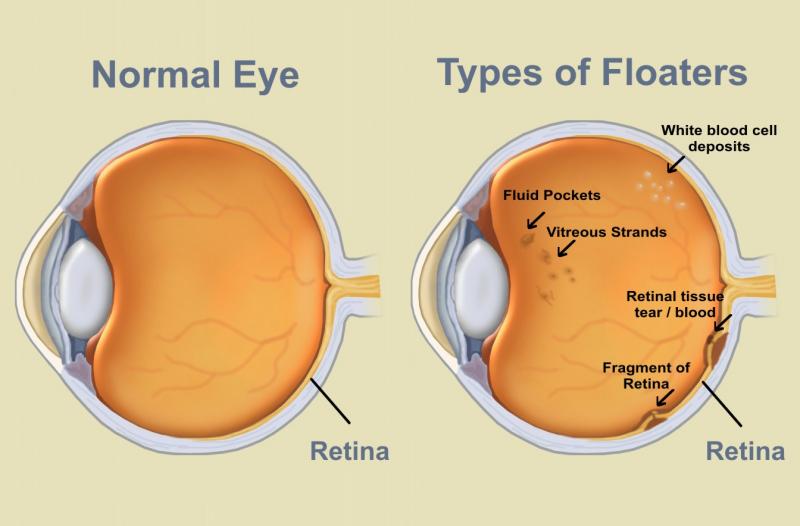
Floaters
Floaters appear as gray or black specks, lines, or “cobwebs” in front of the eyes. As the eyes move, the floaters move too. They do not follow your eye movements precisely, as they usually drift when the eyes start or stop moving.
Floaters are caused by clumps or bits of material suspended in the vitreous jelly that fills the back of the eye. The floaters cast shadows on the light sensitive retina. It is actually the shadow of the floater that you see. Floaters may have a variety of causes, some serious, and some not serious at all (see below).
Flashes
Flashes are sensations of light, when no light is really there. They may appear as many tiny bright lights (like “sparklers”) or like flashes of lightening.
Flashes may occur when the vitreous jelly pulls on or tears the retina. These flashes usually last for only a second or so, but typically occur repeatedly. They may be more obvious with eye movement, or in a dark room.
Some people with migraine headaches may experience a different type of flash. These are usually shimmering, jagged lights that are present constantly for a period of fifteen minutes or so. They typically appear in the center of your field of vision, and progress slowly towards the edges of the visual field. A headache that is commonly throbbing, and on one side of the head, may follow the disappearance of the flashes.
Are floaters and flashes serious?
Many people have floaters. Floaters that you have had for years, and that show little change, are usually not serious. It is the sudden onset of a new floater or floaters that may be serious. The onset of flashes may also be serious.
Anyone with flashes or the sudden onset of a new floater (or floaters) should be examined promptly by an ophthalmologist. The ophthalmologist will perform a dilated fundus exam (looking at the vitreous and retina with specialized equipment after giving drops to enlarge the pupils).
What is the vitreous?
The vitreous is a jelly like material that fills most of the space inside the eye. As we age, the vitreous often liquefies and may collapse.
This is more likely to occur, and occurs much earlier, in eyes that are nearsighted (Myopia). It can also occurs after injuries to the eye or inflammation in the eye.
What is the retina?
The retina is a thin sheet of light sensitive nerve tissue that lines the inside of the eye. It is the tissue that turns light into an electrical signal to send to the brain. It can be compared to the film in a camera.
What will my doctor look for if I have flashes and floaters?
Your doctor will look inside the eye for evidence of disease or damage to the vitreous or retina. The sudden onset of floaters or flashes is often due to a separation of the vitreous jelly from the retina. When this occurs, it tears the retina in about 10% of cases. In most cases, the retina is not torn, and your doctor will examine your eye again at a later date.
What can be done about my floaters and flashes?
Your flashes are likely to go away on their own within a few days or weeks. This may be true even if you have a retinal tear or detachment! It is therefore important to be examined by an ophthalmologist even if your flashes go away on their own.
Floaters tend to last longer than flashes. In most cases, they diminish gradually over weeks or months. Often they do not go away completely. Most people learn to ignore them. Floaters, like flashes, may get better on their own even if a retinal tear or detachment is present. Again, you should be examined even if the floaters seem to be going away.
If you have a retinal tear or detachment, your doctor will talk to you about the treatment
Read More
Read More
Read More
Read More






